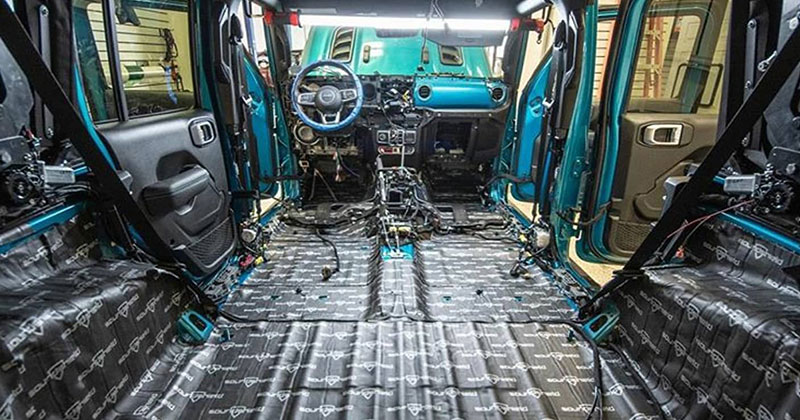For true audio purists, nothing is more frustrating than unwanted resonance muddying an otherwise perfect sound system. Whether it’s the subtle rattle in a door panel or the low-frequency boom echoing through the cabin, these vibrations rob music of its clarity and detail. In vans—especially large cargo or camper models—the problem is magnified by their cavernous interiors and bare metal construction. That’s why investing in a van insulation and soundproofing kit can be a game-changer.
1. Why Resonance Ruins Audio Quality
Resonance occurs when sound waves cause a surface to vibrate at its natural frequency. In a van, these surfaces include doors, floor pans, and roof panels. Instead of letting your speakers deliver pure, uncolored sound, these panels act like unwanted subwoofers, producing distortion and masking fine details.
2. The Purist’s Approach: Treat the Source, Not the Symptom
Instead of cranking up the volume to overpower road noise or rattles, the goal is to eliminate the source of the resonance entirely. This requires a systematic approach—targeting every potential vibration point with effective materials.
3. How a Van Insulation and Soundproofing Kit Helps
A quality kit combines multiple layers of protection:
-
Butyl Rubber Damping Mats – Absorb structural vibrations before they spread.
-
Closed-Cell Foam – Stops airborne noise from bouncing around inside the cabin.
-
Thermal Insulation Layer – Keeps temperatures stable, reducing material expansion and contraction that can create new noises.
By using a van insulation and soundproofing kit, you address both sound quality and comfort in one upgrade.
4. Strategic Application for Maximum Clarity
Audio purists should focus on the following areas first:
-
Front Doors – Prevent resonance directly behind your speakers.
-
Wheel Wells – Reduce tire hum from seeping into the cabin.
-
Roof Panels – Minimize rain drumming and wind turbulence.
-
Rear Cargo Walls – Eliminate echo in large, hollow spaces.
5. Beyond Soundproofing: The Sonic Payoff
Once resonance is tamed, your sound system reveals its full potential:
-
Tight, punchy bass without panel buzz
-
Clear midrange tones with no masking
-
Sparkling highs without harshness
-
A balanced listening environment at any volume
Final Word:
A well-installed van insulation and soundproofing kit doesn’t just make your van quieter—it transforms it into a controlled acoustic space. For the audio purist, this means hearing music exactly as the artist intended, with every note free from unwanted resonance.
For true audio purists, nothing is more frustrating than unwanted resonance muddying an otherwise perfect sound system. Whether it’s the subtle rattle in a door panel or the low-frequency boom echoing through the cabin, these vibrations rob music of its clarity and detail. In vans—especially large cargo or camper models—the problem is magnified by their cavernous interiors and bare metal construction. That’s why investing in a van insulation and soundproofing kit can be a game-changer.
1. Why Resonance Ruins Audio Quality
Resonance occurs when sound waves cause a surface to vibrate at its natural frequency. In a van, these surfaces include doors, floor pans, and roof panels. Instead of letting your speakers deliver pure, uncolored sound, these panels act like unwanted subwoofers, producing distortion and masking fine details.
2. The Purist’s Approach: Treat the Source, Not the Symptom
Instead of cranking up the volume to overpower road noise or rattles, the goal is to eliminate the source of the resonance entirely. This requires a systematic approach—targeting every potential vibration point with effective materials.
3. How a Van Insulation and Soundproofing Kit Helps
A quality kit combines multiple layers of protection:
-
Butyl Rubber Damping Mats – Absorb structural vibrations before they spread.
-
Closed-Cell Foam – Stops airborne noise from bouncing around inside the cabin.
-
Thermal Insulation Layer – Keeps temperatures stable, reducing material expansion and contraction that can create new noises.
By using a van insulation and soundproofing kit, you address both sound quality and comfort in one upgrade.
4. Strategic Application for Maximum Clarity
Audio purists should focus on the following areas first:
-
Front Doors – Prevent resonance directly behind your speakers.
-
Wheel Wells – Reduce tire hum from seeping into the cabin.
-
Roof Panels – Minimize rain drumming and wind turbulence.
-
Rear Cargo Walls – Eliminate echo in large, hollow spaces.
5. Beyond Soundproofing: The Sonic Payoff
Once resonance is tamed, your sound system reveals its full potential:
-
Tight, punchy bass without panel buzz
-
Clear midrange tones with no masking
-
Sparkling highs without harshness
-
A balanced listening environment at any volume
A well-installed van insulation and soundproofing kit doesn’t just make your van quieter—it transforms it into a controlled acoustic space. For the audio purist, this means hearing music exactly as the artist intended, with every note free from unwanted resonance.
1. The Balance Between Performance and Comfort
In performance cars, unwanted noise comes from multiple sources—engine vibrations, tire roar, wind turbulence, and mechanical resonance. Engineers don’t aim for total silence; instead, they filter out the harsh, fatiguing frequencies while preserving a sense of power.
For Sprinter owners, this philosophy applies perfectly. A properly treated van can feel just as refined as a premium sedan, even when loaded for work or adventure.
2. Why the Sprinter Needs Sound Deadening
Sprinters have a large, empty metal shell that acts like an echo chamber. Without insulation, every road vibration and engine pulse bounces around inside. Sprinter van sound deadening targets these problem areas to:
-
Reduce highway drone
-
Cut metal panel resonance
-
Improve in-cabin conversation clarity
-
Enhance overall driving comfort
3. Techniques Borrowed from High-Performance Cars
Performance automakers rely on multiple layers of protection, which Sprinter owners can replicate:
-
Butyl Rubber Damping Mats – Control vibration at its source by treating floor pans, doors, and wheel wells.
-
Acoustic Foam – Traps airborne noise while adding thermal benefits.
-
Mass-Loaded Vinyl (MLV) – Blocks external sounds from entering the cabin.
-
Sealed Door Panels – Just like sports cars, sealing air gaps prevents wind hiss at high speeds.
4. Strategic Placement is Key
High-end car manufacturers don’t just cover everything—they focus on hotspots. For the Sprinter, these include:
-
Front Cab Floor – Major source of engine and transmission noise.
-
Wheel Arches – Constant tire roar area.
-
Roof Panels – Especially loud during rain or at highway speeds.
-
Sliding Door – A notorious culprit for rattles and wind noise.
5. The Unexpected Benefits
While the goal is noise reduction, sprinter van sound deadening also:
-
Improves audio system performance by eliminating panel buzz
-
Keeps the van cooler in summer and warmer in winter
-
Adds a premium, solid feel to doors and panels when closed
Final Word:
Just like a high-performance sports car, a well-soundproofed Sprinter doesn’t mute the driving experience—it enhances it. By adopting similar insulation strategies, your van can combine raw power with refined silence, transforming every drive into a smooth, stress-free journey.


